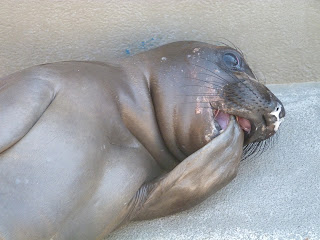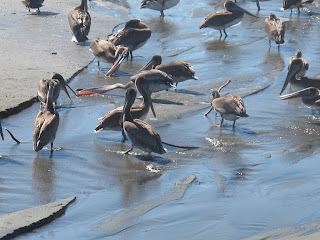Ella is getting bigger every day on her mother's milk. Elephant seal milk starts out watery, at 12 percent fat, and gets progressively thicker as the days go on. Ella will go from her birth weight of 65-80 pounds to about 300 pounds in a month.
Elephant seal mothers do not eat while they are lactating and feeding their pups. Every nutrient that goes into the pup comes directly from her. Her body metabolizes its blubber to make milk. More concentrated milk, with less water, means that much less her body has to produce. By the end of the month of lactation, the milk may be as much as 60 percent fat, making it more like mayonnaise than fluid.
Cow milk is naturally about 3.5 percent fat. Less fat in milk is often desired, and two percent, one percent and fat-free milk are available commercially. Human milk is about 4.5 percent fat.
Ella's mother is getting visibly thinner. She will lose about a third of her body weight by the time she weans her pup.
Veterinarians Rachel Berngartt and Kate Savage volunteer with NMFS' Alaska Marine Mammal Stranding Network during the necropsy of a humpback whale calf that stranded on Baranof Island, Alaska.
Credits: Aleria Jensen, NOAA/NMFS/AKFSC
Strandings occur around the world, involving as few as three to as many as several hundred animals per event. Although a global phenomenon, such strandings tend to happen more often in New Zealand, Australia, and Cape Cod, Massachusetts, said project collaborator Katie Moore, the director of IFAW’s global Animal Rescue Program. Headquartered in Yarmouth Port, Massachusetts, IFAW operates in 40 countries, rescuing animals and promoting conservation to secure a safe habitat for wildlife.
“These locations share some key characteristics, such as the geography, gently sloping beaches, and fine-grained sediment, which we think all play some role in these events,” she said.
Skewed Compasses
Another possibility is that these animals’ internal compasses are somehow skewed by humans’ use of multi-beam echo sounders and other sonar-type equipment used to map the seafloor or locate potential fishing sites, to name just a few applications.
“However, these human-made influences do not explain most of the strandings,” said Pulkkinen, an expert in space weather and its effect on Earth. “Theories as to the cause include magnetic anomalies and meteorological events, such as extreme tides during a new moon and coastal storms, which are thought to disorient the animals. It has been speculated that due to the possible magnetic-field sensing used by these animals to navigate, magnetic anomalies could be at least partially responsible.”
Indeed, magnetic anomalies caused when the sun’s corona ejects gigantic bubbles of charged particles out into the solar system can cause problems for Earth-orbiting satellites and power grids when they slam into Earth’s protective magnetosphere. It’s possible they could affect animals, as well, Pulkkinen said.
“The type of data that Antti has accumulated, together with the extensive stranding data at our disposal, will allow us to undertake the first rigorous analysis to test possible links between cetacean mass strandings and space-weather phenomena,” said Desray Reeb, a marine biologist at BOEM’s headquarters in Sterling, Virginia. Reeb approached Pulkkinen about launching a research effort after hearing his presentation about space weather in June 2015.
Massive Data-Mining Effort
With funding from BOEM and NASA’s Science Innovation Fund, Pulkkinen and his collaborators are carrying out a massive data-mining operation. The team will analyze NASA’s large space-weather databases, including field recordings and space observations, and stranding data gathered by BOEM and IFAW.
The artist’s illustration shows how events on the sun change the conditions in near-Earth space. A Goddard scientist is investigating if solar storms are linked to animal strandings that occur worldwide.
Credits: NASA
The team expects to complete the study by the end of September and publish its findings in a scientific, peer-reviewed journal. Should the study reveal a statistical correlation, team members said the results won’t necessarily imply a causal link. However, it would provide the first thorough research into this hypothesis and offer the first step toward determining if it’s correct.
“Save More Animals”
“The results of this study will be informative for researchers, stranding network organizers, resource agencies and regulatory agencies,” Reeb said. “If we understand the relationship between the two, we may be able to use observations of solar storms as an early warning for potential strandings to occur,” added Moore, who said she “was immediately keen” to get involved in the study. “This would allow stranding responders in global hotspots, and really around the world, to be better prepared to respond, thus having the opportunity to save more animals.”
For more technology-related news, go to: http://gsfctechnology.gsfc.nasa.gov/newsletter/Current.pdf
Lori Keesey
NASA’s Goddard Space Flight Center
NASA’s Goddard Space Flight Center

















































